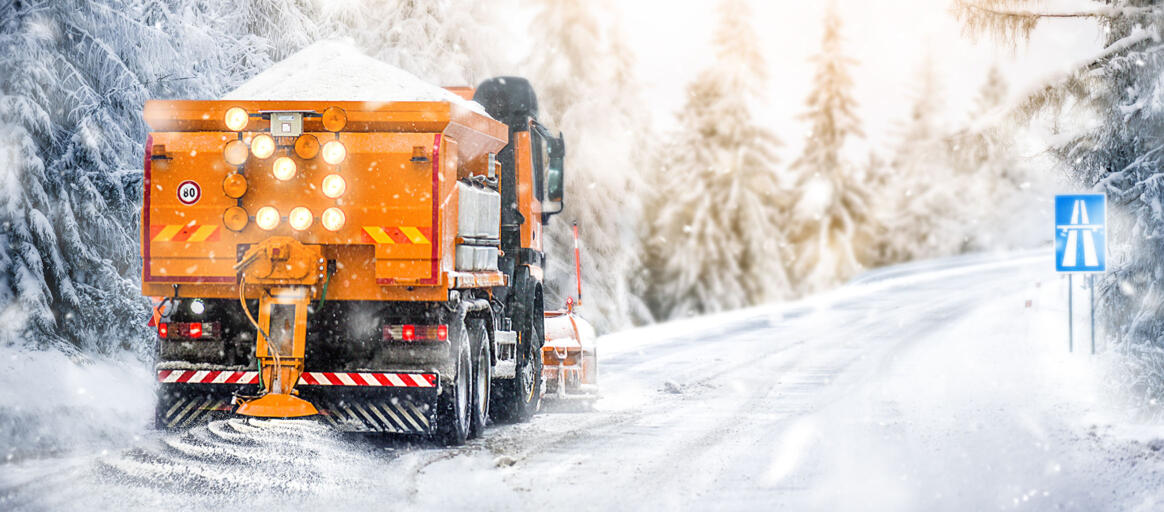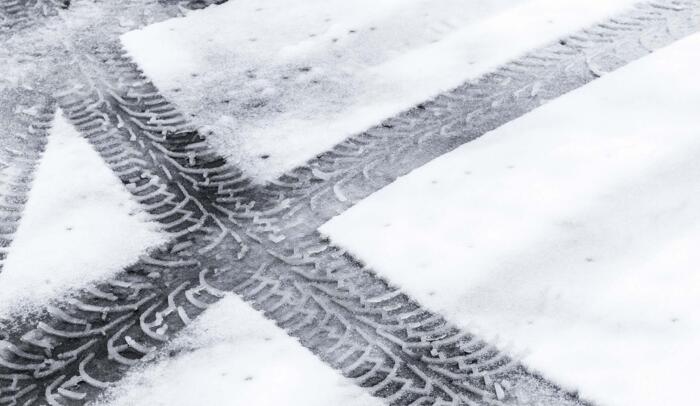De-icing: the efficient use of road salt and other deicing agents
These days, a variety of different deicers is available on the market, but which deicing agent is best suited for the purpose of snow and ice clearance? Especially as not every deicing agent is quite as efficient or the most appropriate choice for the application you have in mind. The differences between deicing salt and other deicing agents: find out more below!

Preventive gritting will save you a lot of needless expenditures. For instance, 1 kg of preventive gritting corresponds with 5 kg of curative deicing salt.
Deicing road salt: different types and applications
Conventional deicing road salt (= sodium chloride) is the most widely used deicing agent. There are three types of salt, which are different in the way they are mined/extracted: vacuum salt, rock salt and sea salt. Vacuum salt is fine road salt that is greatly harmful to the environment because of the extraction process involved. Unless this type of salt is gritted in combination with brine, it will quickly evaporate as it is particularly fine and dry. The extraction of sea salt on the other hand is eco-friendly. Its grains are coarser, giving the salt a longer lasting effect.
Pure deicing salt such as Safe Road Salt is thus the perfect solution to clear driveways and car parks! Especially because it has the right proportion of both fine and coarse salt, which delivers a sterling result. The salt is suited for preventive as well as curative applications. Deicing salt is available in bulk loads as well for large surface areas and for industrial applications.
Ready to use salt brine for deicing!
Ever thought of ready to use salt brine as a thawing agent? ZOUTMAN's pure salt brine which contains 23% sodium chloride (NaCl) is fast and efficient. Freezing point research shows that an NaCl concentration of 23% produces the best result. Salt brine that contains this sodium chloride concentration is able to deal with temperatures of a staggering -21 °C without freezing! Salt brine is best used on a preventive basis or combined with dry salt for curative purposes. In a nutshell, the perfect deicing agent!
Other thawing agents for deicing
Alongside deicing road salt, there are other ways and means to deice surface areas. Deicing granules for instance are a worthy alternative. When the granules come into contact with snow, a chemical reaction occurs whereby heat is released that causes the ice to melt. The NOCOR deicing granules do not contain any chlorine, which makes them ideally suited to deice corrosion-sensitive materials such as aluminium, steel, reinforced concrete or natural stone. NOCOR deicing granules are not harmful to the surrounding fauna and flora and are biodegradable.
In addition, thawing agents exist that are made from calcium chloride for extremely frosty weather conditions. On the one hand, there is SALCO -18, a mixture of deicing salt and calcium chloride. On the other hand, calcium chloride can also be used straight. Do bear in mind that calcium chloride is highly hygroscopic (water absorbing), which makes it more difficult to store. Moreover, it needs to be handled with due care!
How to find the most appropriate thawing agent for deicing?
Selecting the right thawing agent depends on the factors listed below:
- Melting capacity. Compare with 12 kg of ice per kilogram of pure sodium chloride at a -5 °C temperature.
- Usability: What is the freezing-point reducing effect and up to which temperature is the thawing agent effective?
- Availability: Is the thawing agent directly available in sufficiently large quantities? Can the agent easily be stored in large amounts for several years on end?
- The substrate that needs to be deiced: Is it susceptible to corrosion?
- Health and safety: Will you need to put in place radical health and safety measures?
- Environmental health: Does the deicing agent harm the environment? Do not forget that thawing agents are usually used on a large scale for a long duration once the winter hits …
- Price: What about the cost-benefit ratio?
In most cases, going for sodium chloride as a deicing salt is the best choice as it can be used just about everywhere and it is readily available. In addition, it offers best value. Moreover, it will store for long periods of time, it is easier to transport and easy to grit. And there is also the fact that sodium chloride is not harmful to the skin, clothing or the environment.
| Based on | Form | When? | Health and safety | Effective up to: | |
| Safe Road Salt, deicing salt | NaCl | Crystals | Preventive & curative | Safe | -12 °C |
| Salt brine | NaCl | Liquid | Preventive | Safe | -12 °C |
| Salt brine & deicing salt | NaCl | Liquid | Preventive & curative | Safe | -12 °C |
| Salco -18 | NaCl and CaCl2 | Crystals & flakes | Curative | Observe health & safety instructions | -18 °C |
| Calcium chloride | CaCl2 | Flakes | Curative | Observe health & safety instructions | -20 °C |
| Nocor | Grains | Preventive & curative | Safe | -10 °C |
The best result: clear first, grit second
Needless to say preventive gritting is the best option as this will help you prevent most problems. Moreover, gritting on a preventive basis will save you a lot of needless expenditures. For instance, 1 kg of preventive gritting corresponds with 5 kg of curative deicing salt. If your preventive gritting efforts failed to keep the ice and snow sufficiently at bay, make sure you clear the snow first, before tackling the surface area with deicing salt or deicing granules. This will produce the most efficient result!
